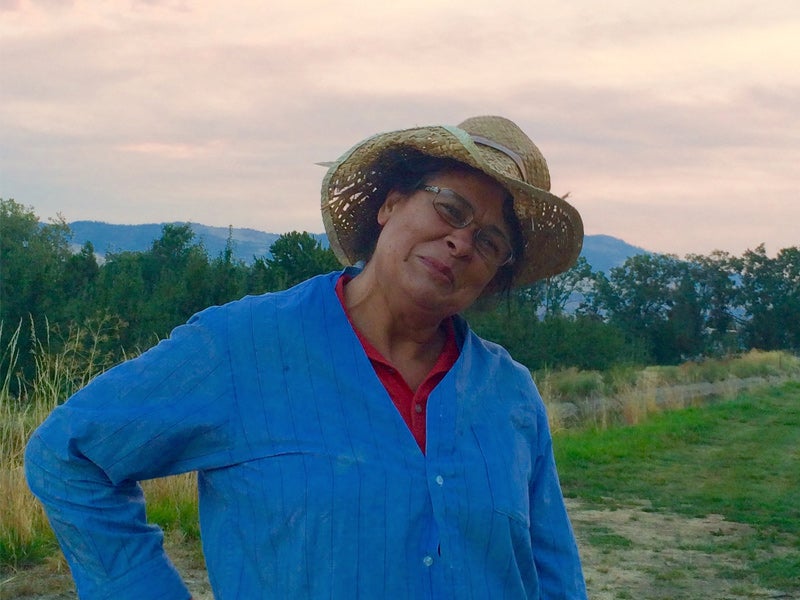The Climate Story of a Farmworker’s Daughter
Rarely, if at all, are we given insight into the perspectives of people who are experiencing climate change minute-to-minute.

This page was published 9 years ago. Find the latest on Earthjustice’s work.
Everyone has their own story. Mine is simple. My mother raised us humbly; we didn’t have more than what we needed, but she always prioritized buying organic food, having had first-hand experience with the chemicals growers spray in the fields. She has spent the majority of her life outdoors and as a result, her knowledge about plants and the seasons is much deeper than most anyone else I know.
In her 35 years as a farmworker she has harvested grapes, tomatoes, pears, cherries, oranges, blueberries and strawberries, along with growing her own chilies, beans, squash and ancestral corn. She migrated to California from Michoacán, Mexico, in her early 20s and followed the harvest up to southern Oregon in the Latgawa Valley, which is where my three siblings and I were born.
Having never made more than $13,000 a year, Mom never hesitated to bring us with her to work, “para que aprendan como su madre se gana la vida” (so you can learn how your mother earns her living), she would tell us. Whether it was picking grapes, blueberries or strawberries or waking up at 2am to light the orchard heaters to prevent the pear blossoms from freezing, Mom was always observant of weather changes, cloud patterns and temperature fluctuations. These factors would determine whether we’d go to work, plant or harvest anything.
This is why I say that no one knows the land, the waters and the seasons more intimately than someone who spends the majority of his or her life working with the elements. That’s why, if you want to get a real perspective on climate change in the U.S., you should ask a farmworker.
As a communications intern at Earthjustice, I watch news outlets closely on a daily basis. There are undeniable trends in the climate change discourse, largely around whether it’s too late to make a change or if we’ve already gone past the point of no return. These stories always highlight statistics and calculations from climate scientists, as well as their predictions about whether or not there’s still hope for humanity and the rest of life on this planet. Rarely, if at all, are we given insight into the narratives of those who are experiencing the climate shifts minute-to-minute. The media is flooded with big-picture theories, but readers are rarely given the small, localized perspective of those who are exposed to these changes.
My mother might not consider herself an environmentalist, let alone a climate justice advocate, but she has been experiencing the effects of climate change since before the climate movement began. For years she has been voicing her concerns, noticing that each year everything bloomed sooner; that the seasons were out of balance; that the rain was not arriving when it was needed; that each year she had to plant her seeds sooner and tend to her plants more than usual.
As I’ve begun to gain a deeper understanding of the global environmental and climate justice movement, I’ve realized that my mother and other farmworkers in the U.S. are not alone. I’ve realized that indigenous people all over the world are being displaced by shifting climates, that many communities of color in the U.S. are being disproportionately exposed to the pollution generated by industries contributing to climate change and, more than anything, that the communities least responsible for climate change are the ones being impacted the most. How is this possible?
The global cry for climate action is being heard loud and clear, but what are we doing to bring in the voices of those who are already suffering the climate consequences? While politicians all over the world discuss international strategies for targeting climate change, people who are affected by the change on a day-to-day basis are losing their homes, their crops and even their lives. Since 2005, at least 26 farmworkers have died from heat-related causes in the state of California alone, and these stories are not receiving the attention they deserve.
It would be a disservice to this momentous movement not to make an effort to include the struggles of the people feeding the movement who can’t easily access the mic. To strengthen individual voices in the climate justice movement, we need to pass the mic and make sure that marginalized communities who have first-hand experience of what’s going on outdoors get a chance to speak their truth. This is the only way we can build solidarity within the climate justice movement. The climate struggle belongs to all of us.